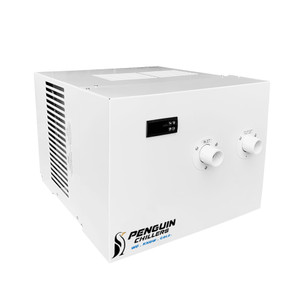
- 5 Horsepower
- 25,000 BTU
- 1″ FPT inlet/outlet ports (Female Threaded PVC)
- Corrosion resistant titanium heat exchanger, Copper never comes into contact with the water = Reef Tank Safe
- Pump recommendation (pump not included) : 500 gph – 1800 gph @ less than 10 psi
- Lowest recommended operation 40F-50F (achieving these temperatures is highly dependent on application)
- 208-230v (single phase) / 10.5a-11.6a / 2410W
- Plug type: Nema 6-20P
- 6′ power cord
- 106 lbs
- 61 dBA (Quiet)
- 28″L x 24″W x18″H
- 1 year warranty
- Proudly Built in USA
Penguin Chillers are constructed using high grade materials to quickly and efficiently chill liquids. Chillers are designed with oversized titanium coils, the extra surface area allows for faster and more efficient cooling plus titanium stands up to the harshest of corrosive environments without leaching.
Applications include:
- Marine / Reef Tanks
- Bait Tanks
- Lobster Tanks
- Hydroponics
- Aquaponics
Additional Information:
Chiller Sizing
Sizing a chiller can be a difficult decision.
Factors that affect chiller performance include:
- Volume of liquid
- Heat inputs = lighting, pumps, etc.
- Ambient Temperatures
- Desired goal temperature
- Some specialized applications have specific time requirements to cool from specific temperatures or flow rates that must be considered.
The most common error is underestimating how much heat is being put into the water. A common answer to the question – “What is the heat load?” is “Not much.” If the heat load is unknown, one of the best ways to estimate it is to get your system to goal temperature using ice or other means. Pull all the ice out and then time how rapid the heat gain is. If you know the volume of water and the time it takes to go from one specific temperature to any other specific temperature, an estimated heat load can be calculated. (Reference What is BTU) It’s still just an estimation, but it’s a lot better than a “not much” type of answer.
When it comes to chillers in general, it’s pretty much impossible to oversize a chiller for your project. The general rule of thumb is when in doubt, go with the next size up! It never hurts to have extra cooling power. A common misconception is that a bigger chiller will use more electricity. Under that logic, consumers often try to squeeze into a chiller that may be too small for their project, which then causes the unit to run more often than needed had they gone up a size. Think of it this way. Your chilling workload will not change regardless of using a small or large chiller. It will take roughly the same amount of electricity to do the amount of work. It is true, a larger chiller will use more electricity when running, however, it will need to run much less often. Also, if your chiller is undersized, it may not reach your desired goal temperature, which will cause it to run more often. Finally, keep in mind that the larger chiller running less often will be more likely to have a longer life span than the smaller chiller running more often. In the end, after considering all the variables and looking at the bigger chilling picture, it seems to be a safer bet to upsize and select the larger chiller.
What is BTU
BTU (British Thermal Unit) is a unit of measure often used to describe chiller capacity. A single BTU is the amount of energy required to raise one pound of water one degree Fahrenheit. Penguin Chillers use BTU/hr as a measurement of work being done per hour. Penguin chillers are rated in BTU/hr, this is the capacity of cooling the chiller can perform in an hour.
For example, if we wanted to cool 100 gallons by 10 Fahrenheit, we first need to know that 100 gallons weigh about 832 lbs. 832 lbs of water x 10 Fahrenheit = 8,320 BTU. This is a straight calculation that does not consider any heat sources trying to warm the water.
Another consideration is that with any refrigeration equipment with a BTU rating, there are certain assumptions about environmental conditions to arrive at that rating. On a typical aquarium chiller, the rating will be valid at a specific water and air temperature, normally both are around 80 Fahrenheit. For example, a 5,000 BTU chiller has the capability of 5,000 BTU of cooling at 80F water and air temperatures. If the water is colder or the air is hotter the chiller won’t be able to cool as effectively therefore while the chiller is rated at 5000 BTU it may only be able to provide a fraction of that. Eventually, if the water gets cold enough or the air gets hot enough, the chiller will arrive at 0 BTU/hr and won’t be able to cool any further. Likewise, in the opposite situation, if the water is warmer than 80F and the air is cooler, the chiller can provide more than 5,000BTU of cooling. The key point is that the chiller’s ability to cool is on a sliding scale that is dependent upon both water and air temperatures.
In order to cool a body of water, the chiller needs to offset more heat than the amount of heat being put into the water. Heat can come from many sources – ambient air, pumps, lights, sun, etc. The tough part is knowing how much heat in BTU/hr is going into the water. For electrical items we can use wattage to estimate how much heat they produce. A watt is equal to 3.41 BTU. Therefore a 100-watt submersible pump has 341 BTU/hr is going into the water. For a 250-watt metal halide light we can calculate it produces 852 BTU/hr, however, it is a lot more difficult to figure out how much of that heat is being transferred to the water. Factors like bulb distance to water, water surface area, and even reflectivity of material in the tank would factor into how much of the 852 BTU/hr from the bulb are being transferred. As you can see, the math/science to actually assign values to the various heat inputs gets very complicated very fast.
Because the consumer market insists on sizing chillers in terms of horsepower (HP), therefore Penguin Chillers describe and name their chillers with a horsepower (HP) rating. Penguin Chillers need consumers to keep in mind that a chillers BTU’s/hr is really the best way to measure the chillers capacity. If you compare multiple brands of 1/2 HP chillers, you will likely discover a variety of different BTU/hr ratings. What this means is that each chiller doesn’t really have the same capacity as we’re led to believe by all of them having the same 1/2 HP name. For example, the 1/2 HP Active Aqua chiller lists a BTU/hr rating of 4100 while Penguin Chillers brand 1/2 HP chiller has a BTU/hr rating of 5000. Many brands don’t advertise their BTU/hr ratings therefore it is important to do your research when making your chiller selection.
Now that you have a general understanding of the basic BTU calculations and why they are so important you should now be able to arrive at a good “guesstimate” when selecting the right chiller for your project.











